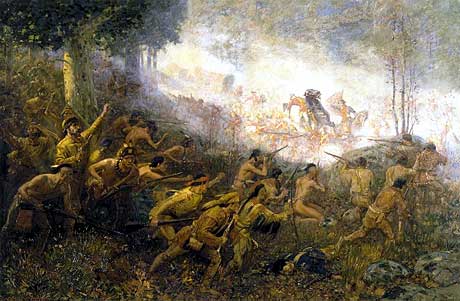Braddock's Defeat
Part of a global conflict between the French and the British, the battle is the result of a major English offensive to take control of what is called the Ohio Country by way of capturing Fort Duquesne with a 2,100 man force under the command of 60-year-old Major General Edward Braddock (he is the son of a former major general of the elite Coldstream Guards).

Facing the logistical nightmare of moving his force, including the heavy cannons needed for siege work against forts, through 110 miles of raw wilderness, Braddock sets out from Fort Cumberland in Maryland on May 29th, creating a road as he goes that he can use for being resupplied once Fort Duquesne is his. No subtlety in the movement, the French and Indians in the region are well aware that their foe is coming.

Region of conflict
A defensive position controlling the site where the Ohio, Alleghany, and Monongahela Rivers all meet, the French garrison at Fort Duquesne consists of about 250 regular soldiers and Canadian militia under the command of Claude-Pierre Pecaudy de Contrecoeur, and about 640 Indians camping in the forest lands near the structure ... a mixed grouping of warriors from the Ottawa, Ojibwa, and Potawatomi tribes (in contrast, Braddock moves forward with only 8 Mingo tribe scouts).
 Watching the British
Watching the British
Realizing he can not withstand a prolonged siege by a superior force, de Contrecoeur decides to launch a preemptive strike against the British ... and times the attack perfectly, hitting Braddock's force as it crosses the Monongahela River, and as the British general has split his force into a "flying column" of 1.300 men, and a support unit carrying most of the force's baggage. The Indians are at first reluctant to attack such a large force, but when French field commander Captain Daniel Lienard de Beaujeu covers his face in war paint, the native warriors are convinced to participate.
 Battle
Battle
Not expecting to encounter any hostiles until they get closer to the fort, an advance force of 300 men led by Lt. Colonel Thomas Gage (the British commander of English forces in North American when the American Revolution begins 20 years later) runs headlong into Indians rushing to the river to set up an ambush. In the initial clash, de Beaujeu is killed, but instead of unhinging the French and Indians, they swarm the flanks of Gage and force him to retreat ... right into Braddock's main force, which has come forward at the sound of battle. Chaos ensues as the forces crash into each other on the small road ... mayhem added to by warriors screaming and shooting from within the safety of the surrounding dense forest, and nailing scalps of fallen British soldiers to trees ... and in the confusion, several British platoons will fire on each other. In the next three hours, the British try to reform their units again and again, but the road, forest, and sniping of the French and Indians prevent suitable cohesion ... the only thing preventing a rout is the calming effect Braddock has in rallying his men. Then Braddock is shot off his horse (a bullet through the lung that will take the general's life on July 13th).
 Braddock goes down
Braddock goes down Braddock
Braddock
Effective resistance collapsing, a total massacre is prevented when one of the colonists with Braddock, though he has no official position in the British chain-of-command, forms a rear guard that allows the rest of Braddock's force to disengage, and by sunset, retreat back down the road they have built ... a colonel from Virginia named George Washington (a lucky survivor of the clash, unscathed, the future first President of the United States will have two horses shot out from under him, and after the battle discover four different bullet holes in his clothing). Also allowing the British to escape a worse mauling, instead of pursuing the British, the Indians involved set about scalping and looting the corpses of the fallen that litter the road ... and get blasted on two hundred gallons of captured British rum (before he dies on the 13th, Braddock gives Washington the ceremonial sash he wore with his battle uniform, a gift Washington never goes anywhere without ... for the rest of his life ... the sash now resides, on display, at Washington's Mt. Vernon home!).
 Colonel Washington
Colonel Washington
A major ouch (though the British will eventually prevail in the war), the Braddock force suffers casualties of 456 men killed (the officers are especially hit hard, of the 86 that go into the battle, 26 and killed and 37 are wounded) 422 soldiers are wounded, and of the 50 women that are along as cooks and maids, only 4 make it back to civilization ... to minuscule losses for the French and Indians, of 30 killed and 57 wounded.
 Farewell General Braddock
Farewell General BraddockBraddock's last words are said to be, "Who would have thought?" Indeed ... who would have thought?

Just Before The End - Braddock And Aides
No comments:
Post a Comment